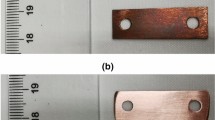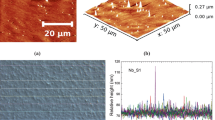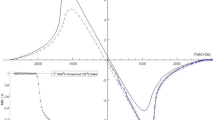Abstract
The standard preparation of superconducting radio-frequency (SRF) cavities made of pure niobium include the removal of a “damaged” surface layer, by buffered chemical polishing (BCP) or electropolishing (EP), after the cavities are formed. The performance of the cavities is characterized by a sharp degradation of the quality factor at high surface magnetic field, a phenomenon referred to as “Q-drop”. In some cases, the Q-drop can be significantly reduced by a low-temperature (~120 °C) “in situ” baking of the cavity. As part of the effort to understand this phenomenon, the effect of introducing a polarization potential during BCP, creating a process which is between the standard BCP and EP, was investigated. The focus of this contribution is on the characterization of this novel electrochemical process by measuring polarization curves, etching rates, surface finish, and electrochemical impedance. In particular, it is shown that the anodic potential of Nb during BCP has a plateau region in the polarization curve and the impedance diagrams on the plateau can be described with a “surface charge” model found in the literature. By applying an anodic potential to Nb, a lower etching rate and better the surface finish than by standard BCP process have been obtained.










Similar content being viewed by others
References
Kneisel P (2006) Nucl Instrum Methods A557:250
Lilje L (2001) PhD Thesis, University of Hamburg, Hamburg, Germany
Tian H (2008) PhD Thesis, The College of William & Mary, Williamsburg, Virginia, USA
Ciovati G (2006) Physica C 441:44
Saito K (2007) In: Proceedings of the 13th workshop on RF superconductivity, Beijing, China, TU202
Kneisel P, Myneni GR, Ciovati G, Sekutowicz J, Carneiro T (2007) AIP Conf Proc 927:84
Halbritter J, Kneisel P, Palmieri V, Pekeler M (2001) IEEE Trans Appl Supercond 11:1864
Halbritter J (1987) Appl Phys A 43:1
Ciovati G, Corcoran S G, Halbritter J (2007) In: Proceedings of the 13th workshop on RF superconductivity, Beijing, China, TUP17
Bojinov M (1997) J Solid State Electrochem 1:161
Barsoukov E, Ross Macdonald J (2005) Impedance spectroscopy: theory, experiment, and applications. Wiley-Interscience, New York
Tian H, Corcoran SG, Reece CE, Kelley MJ (2008) J Electrochem Soc 155:D563
Kneisel P (1980) In: Proceedings of the 1st workshop on RF superconductivity. Karlsruhe, Germany, p 27
Magaino S, Matlosz M, Landolt D (1993) J Electrochem Soc 140:1365
Matlosz M, Magaino S, Landolt D (1994) J Electrochem Soc 141:410
Cattarin S, Musiani M, Tribollet B (2002) J Electrochem Soc 149:B457
Rigo S, Siejka J (1974) Solid State Commun 15:259
Pringle JPS (1980) Electrochim Acta 25:1423
Orazem ME, Tribollet B (2008) Electrochemical impedance spectroscopy. Wiley-Interscience, New York
Brug GJ, Van Den Eeden ALG, Sluyters-Rehbach M, Sluyters JH (1984) J. Electroanal Chem 176:275
Hsu CH, Mansfeld F (2001) Corrosion 57:747
Robinson MLA, Roetschi H (1968) J Phys Chem Solids 29:1503
Gallego JM, Thomas CB (1983) Solid State Commun 47:419
Di Quarto F, Piazza S, Sunseri C (1990) Elecctrochim Acta 35:99
Zhao X, Ciovati G, Bieler TR (2010) Phys Rev ST Accel Beams 13:124701
Acknowledgments
The authors would like to acknowledge O. Trofimova of the College of William and Mary for helping with the optical microscope and AFM measurements. This research was conducted at Thomas Jefferson National Accelerator Facility, operated by Jefferson Science Associates, LLC under U.S. DOE Contract No. DE-AC05-06OR23177. The U.S. Government retains a non-exclusive, paid-up, irrevocable, world-wide license to publish or reproduce this manuscript for U.S. Government purposes.
Author information
Authors and Affiliations
Corresponding author
Rights and permissions
About this article
Cite this article
Ciovati, G., Tian, H. & Corcoran, S.G. Buffered electrochemical polishing of niobium. J Appl Electrochem 41, 721–730 (2011). https://doi.org/10.1007/s10800-011-0286-z
Received:
Accepted:
Published:
Issue Date:
DOI: https://doi.org/10.1007/s10800-011-0286-z




